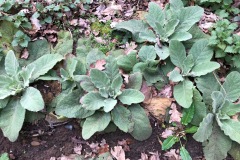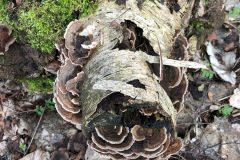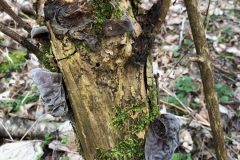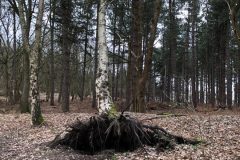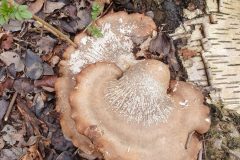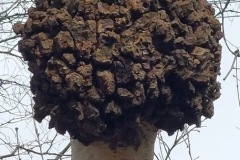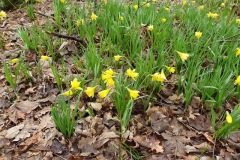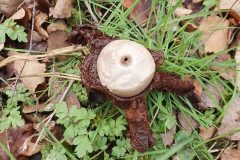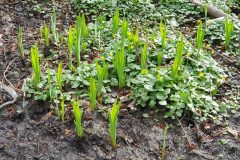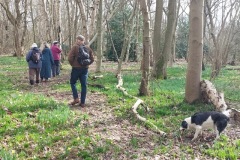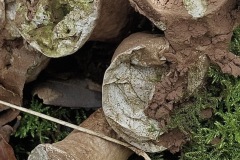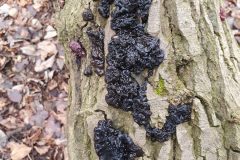Leader : Jim Burnett
Members attending: Nora (B), Caroline (B), Paul & Joyce (S), Gerri (S), John (N) & Colin (H).
We assembled at 10:30am on the roadside verge in Harwell Sluice Lane (SK686 917) and set off along the delightfully floriferous Pinfold Lane to the Barrow Hills Sand Pit SSSI (at SK679 918). Then on to the footpath at around the relatively alpine 40 metre contour around the circumference of Barrow Hills Plantation, the highest hill for miles around. At lunch amongst ancient coppiced Oaks and Sweet Chestnuts we were able to look down over the Everton Carrs, the Idle Valley and out across the Humberhead Levels to the north, were common spot-heights were around 3 metres.
Introduction
Harwell is a hamlet in the civil parish of Everton, in the Bassetlaw district of north Nottinghamshire. It is located off the A631 road, three miles east of Bawtry. The main local landscape feature is the Barrow Hills woodland, immediately to the northwest. Barrow Hills Sandpit, an area of grassland and scrub on glacial sands at SK682917 is a 1.87ha Site of Special Scientific Interest and Barrow Hills Plantation is a Local Wildlife Site of 48.88ha.
What is Barrow Hills made of? The geology of the site is underlain by Triassic Mercia Mudstone, a calcareous aeolian (wind-blown) desert sediment which is overlain by Glacial Fluvial Deposits of Sands and Gravels. Considering the majestic nature of this landscape feature, this is a rather pedestrian description.
Habitat description (from the Natural England SSSI citation):
The site comprises a fine example of species-rich grassland and scrub developed on freely-draining unconsolidated sands of glacial origin and is representative of grassland developed on base-rich sandy soils in the North Midlands.
Biology: A series of sandy soils of varying base-status has been exposed by old sand workings into the south-facing slope of part of the Barrow Hills.
On the upper soils of the quarries, where the leached sandy soils are acidic in character, the ground vegetation is dominated by common bent Agrostis tenuis, bracken Pteridium aquilinum and sheep’s sorrel Rumex acetosella and contains such typical heathland plants as heath bedstraw Galium saxatile. Areas of acid scrub including patches of gorse Ulex europaeus and broom Sarothamnus scoparius.
Lower down quarrying has exposed mineral sandy soils containing abundant chips, pebbles and nodules of limestone. Here rabbit grazing maintains areas of herb-rich short sward dominated by silver hair grass Aira caryophyllea and sheep’s fescue Festuca ovina and containing such characteristic sandland plants as common stork’s-bill Erodium cicutarium, buck’s-horn plantain Plantago coronopus, hoary cinquefoil Potentilla argentea, biting stonecrop Sedum acre, common whitlow grass Erophila verna, lesser hawkbit Leontodon taraxacoides, restharrow Ononis repens and viper’s-bugloss Echium vulgare.
Parts of the sandpit consist of areas of bare sand, while others have been colonised by scrub which is characterised by the abundance of wild privet Ligustrum vulgare, rose Rosa spp, hawthorn Crataegus monogyna and ash Fraxinus excelsior together with a few specimens of buckthorn Rhamnus catharticus. The mix of habitats present is ideally suited to support a diverse invertebrate fauna.
Notes: Although we were a little early for the blooming of the carpets of Bluebells and other spring flowers, a highlight of the woodland was the discovery of numerous and quite extensive beds of Moschatel (Adoxa moschatellina) emerging through the deciduous leaf litter, one patch measuring 15m x 4m!
The lofty nature of the site exposed the trees to savage wing-throw. This was more evident on the north-western side with several mature pines toppled, exposing up-ended root plates, the sandy soil ideal for colonisation by mining bees. Where the downed pines trunks had been chain sawed, Jim counted the growth rings, indicating this commercial timber crop had been planted at least 60 years ago (i.e. in the 1960s). Lying tree trunks, both coniferous and deciduous revealed numerous emergence holes of timber beetles and their parasites, the identification of which would make a project for future visits.
Thanks to Jim for leading an interesting excursion with agreeable company.
Species recorded included the following: (species in bold were in flower)
| Latin Name | Vernacular Name | Pinfold Lane | Sandpit | Woodland |
|---|---|---|---|---|
| Acer pseudoplatanus | Sycamore | * | * | |
| Adoxa moschatellina | Moschatel | * | ||
| Anenome nemorosa | Wood Anenome | * | ||
| Anthriscus sylvestris | Cow parsley | * | * | |
| Arrenatherum elatius | False Oat-grass | * | ||
| Artemisa vulgaris | Mugwort | * | * | |
| Arum maculatum | Arum | * | * | |
| Betula pendula | Silver birch | * | * | |
| Buddleija davidii | Buddleija | * | * | |
| Capsella bursa-pastoris | Sheperd’s Purse | * | ||
| Carex sylvatica | Wood Sedge | * | * | |
| Castanea sativa | Sweet Chestnut | * | ||
| Cardamine flexuosa | Wavy Bitter-cress | * | * | |
| Cirsium arvense | Creeping thistle | * | ||
| Circium vulgare | Spear Thistle | * | * | * |
| Chamerion angustifolium | Rosebay | * | ||
| Claytonia perfoliata | Spring Beauty (or Miner’s Lettuce) | * | * | * |
| Corylus avellana | Hazel | * | * | |
| Crataegus monogyna | Hawthorn | * | * | * |
| Cyclamen hederifolium | Cyclamen (This and other miniature hardy species were thriving in gardens and emerging onto the verge) | * | ||
| Dactylis glomerata | Cock’s-foot | * | * | |
| Deschampsia cespitosa | Tufted hair-grass | |||
| Digitalis purpurea | Foxglove | * | * | |
| Dryopteris filix-mas | Male-fern | * | * | |
| Erophila verna | Whitlow Grass | * | ||
| Fraxinus excelsior | Ash | * | * | |
| Galanthus nivalis | Snowdrop | * | ||
| Geranium lucidum | Shining Cranesbill | * | ||
| Geranium molle | Dove’s-foot Cranesbill | * | * | * |
| Geranium robertianum | Herb-robert | * | * | * |
| Glechoma hederacea | Ground-ivy | * | * | * |
| Hedera helix | Ivy | * | * | * |
| Helleborus foetidus | Stinking Hellebore | * | ||
| Holcus mollis | Creeping soft-grass | * | ||
| Ilex aquifolium | Holly | * | * | |
| Juglans regia | Walnut (Old specimen in 19th century cottage garden) | * | ||
| Lamium album | White Dead-nettle | * | * | |
| Lamium purpureum | Red Dead-nettle | * | * | |
| Ligustrum ovalifolium | Garden Privet | * | ||
| Ligustrum vulgare | Wild Privet | * | * | |
| Lonicera periclymenum | Honeysuckle | * | * | |
| Pinus nigra | Corsican Pine | * | ||
| Plantago major | Greater Plantain | * | ||
| Pteridium aquilinum | Bracken | * | * | |
| Quercus robur | Pedunculate Oak | * | * | |
| Ranunculus ficaria | Lesser Celandine | * | * | * |
| Ranunculus repens | Creeping Buttercup | * | ||
| Ribes uva-crispa | Gooseberry | * | ||
| Rosa sp | Rose | * | * | * |
| Rubus fruticosus | Bramble | * | * | * |
| Sambucus nigra | Elder | * | * | * |
| Scrophularia nodosa | Figwort | * | * | |
| Silene dioica | Red Campion | * | * | * |
| Sorbus aucuparia | Rowan | |||
| Stachys sylvatica | Hedge Woundwort | * | * | |
| Stellaria media | Common Chickweed | * | * | * |
| Symphytum officinale | Comfrey | * | * | |
| Taxus baccata | Yew | * | ||
| Teucreum scorodonia | Wood Sage | * | * | * |
| Urtica dioica | Common nettle | * | * | * |
| Veronica hederifolia | Ivy-leaved Speedwell | * | * | |
| Veronica persica | Field Speedwell | * | * | |
| Viburnum opulus | Guelder Rose | * | * | |
| Vinca minor | Lesser Periwinkle | * | ||
| Viola | Violets | * | * | * |
| Latin Name | Vernacular Name | Pinfold Lane | Sandpit | Woodland |
|---|---|---|---|---|
| Auricularia auricula-judae | Jelly-ear Fungus (on dead elder) |
* | ||
| Latin Name | Vernacular Name | Pinfold Lane | Sandpit | Woodland |
|---|---|---|---|---|
| Picus viridis | Green Woodpecker calls [also workings on oak stump] | * | ||
| Sitta europaea | Nuthatch (calling) | * | ||
| Prunella modularis | Dunnock (singing) | * | ||
| Passer domesticus | House Sparrow (calling) | * | ||
| Fringilla coelebs | Chaffinch (singing) | * | * | |
| Regulus regulus | Goldcrest (singing) | * | ||
| Aegithalos caudatus | Long-tailed Tit | * | * | |
| Periparus ater | Coal Tit 3 (feeding in Larch) | * | ||
| Parus major | Great Tit (calling) | * | * | * |
| Erithacus rubecula | Robin (singing) | * | * | * |
| Turdus merula | Blackbird | * | ||
| Buteo buteo | Common Buzzard (calling) | * | ||
| Columba palumbus | Wood Pigeon | * | * | |
| Corvus corone | Carrion Crow | * | * | |
| Corvus frugilegus | Rook | * | * | * |
| Latin Name | Vernacular Name | Pinfold Lane | Sandpit | Woodland |
|---|---|---|---|---|
| Talpa europaea | Mole [hills] | * | * | * |
| Sciurus carolinensis | Grey Squirrel | * | ||
| Oryctolagus cuniculus | Rabbit (Much grazing and digging activity) | * | * | |
| Latin Name | Vernacular Name | Pinfold Lane | Sandpit | Woodland |
|---|---|---|---|---|
| Gonepteryx rhamni | Gonepteryx rhamni 2 | * | * | |
| Vanessa atalanta | Red Admiral 1 | * | ||
| Pararge aegeria | Speckled Wood 1 | * | ||
| Coccinella septempunctata | 7 spot Ladybird | * | * | * |
| Bombus pratorum | Early Bumblebee | * | ||
| Bombus lucorum | White-tailed Bumblebee | * | * | |
Leader : Colin Howes.
Members attending: Helen (K), Louise (H), Jerri (S), Jim (B), Ian (F), Tony (F) and Tim (K).
(Apart from Ian who had to leave the field with a footwear problem, “we counted them all out … and counted them all back”).
We met at 1pm on Archers Way [formerly Butt Holes Lane of hallowed memory] (SK524988) off the A630 Doncaster/Conisbrough Road. After a pep talk about the significance of Nearcliff Wood and the Don Gorge for Ice-age mammal remains, bat hibernation sites and its former popularity as a tourist venue for spring flowers and spectacular vistas, we crossed the A630 via the convenient pelican crossing and entered Nearcliff Wood via the open haul road.
Our general route was to proceed along the haul road and head as far as the disused worked out Nearcliff limestone quarry below Butterbusk Green, calling on significant sites on route.
Firstly, we detoured along the path to look at the pipe tunnel ravine, pipe tunnel portal and Cadeby Viaduct. At the first limestone outcrop on the left (SK524991) Louise triumphantly re-found a population of the Fingered Sedge Carex digitata formerly discovered here by celebrated Nats member Ian Mcdonald. She explained that its presence in South Yorkshire seems to be focussed on eastward flowing glacial overflow channels/river systems through the Mag Limestone ridge, as in the Don Gorge and Roche Abbey. It was initially confirmed in the Don Gorge at Levitt Hagg in 1844, though an earlier local record was at Edlington Wood where Thomas Tofield found it in 1779!
At the pipe tunnel portal (SK526992) the leader gave a talk about the hibernating bats recorded here on previous winter excursions. These included Brown Long-eared Bat, Whiskered Bat, Natterer’s Bat and Daubenton’s Bat. An explanation was given of the condensation effect of the moist air exiting the pipe tunnel, giving rise to the lush fern and bryophyte flora on the ravine sides … a phenomenon worthy of further study (oh how we miss Colin Wall on these occasions).
Re-joining the haul road, just beyond the viaduct, Jim found a clump of cowslip/false Oxlip/polyanthus in bloom. The absence of gene donor (parent) primroses and cowslips in the vicinity placed a question mark over just what it was and a garden throw-out seemed a possible origin. Louise took a sample and emailed that “The cowslip/false Oxslip thing is causing me grief. The flowers are not big enough for False Oxslip. It keys out as Cowslip. It is possible that the petals had not fully expanded on the flower I took.”
Also, regarding an interesting Fumitory sample collected in the gorge, she later emailed “The Fumitory keyed out as F. muralis – Yippee! This is probably only the second time I’ve found a Fumitory that is not just the bog standard officinalis (and believe me, I’ve looked at many).”
Further along we detoured into the overgrown quarry containing the so-called ‘Dragon Cave’ (SK527994) where in extreme hot or cold conditions the moist subterranean airflow from the cave condenses into a plume of mist, giving rise to the dragon folklore. The upper and lower pothole entrances were examined (but not entered) by Jim. From a track running round the back of the quarry the contorted and fractured limestone strata was observed in the quarry sides, overlain by a cryoturbated zone below the woodland topsoil. Also at the back of the quarry a waterfall emerged from the cliff top (one of the very few waterfalls in the Doncaster region), the water presumably emanating from an overflow from the adjacent Butterbusk Water Tower (a phenomenon to be investigated on a subsequent occasion).
On reaching the Nearcliff Quarry we detoured to the right, ascending a very steep and deeply gullied track to the top of an isolated fragment of limestone woodland. This site had been investigated in the late 1990s by Nats members Jim Griffith and Mick Oliver who discovered numerous plants of Spurge Laurel and Stinking Hellebore, the latter so abundant it could have been a commercial crop. Since the 1990s the wood has been eroded by off-roaders, indeed since my recent reconnoitre in preparation for this visit, yet more of the woodland had been eroded away, this time in removing trees and shrubs around the pole carrying the power cables across to the quarry works on the Cadeby side of the gorge.
Despite the precipitous nature of the site and the tangle of shrubs, all members entered the wood and were able to join in counting the target plants. Across the upper slope, beneath the tree canopy there were approximately 71 plants of Spurge Laurel (Daphne laureola), most in flower and 17 plants of Stinking Hellebore (Helleborus foetidus), a good number in such a restricted area but a poor crop compared with its status in former days. Although some Hellebores were reasonably large flowering specimens, there were numerous small, non-flowering plants, possibly indicating the population performs in a cyclic pattern and these young plants were beginning the build up for a good showing in future years. It may be that mature plants only have a limited life span. An examination of photographs of earlier visits show the population was of large or dying (blackening) plants with few young examples.
Woody plants in the woodland included Ash (Fraxinus excelsior), Dogwood (Cornus sanguinea), Bramble (Rubus fruticosus agg.), Buddleia (Buddleja davidii), Elm sp. (Ulmus sp.) Yew (Taxus baccata), Hazel (Corylus avellana), Holly (Ilex aquifolium), Sycamore (Acer pseudoplatanus), Grey Willow (Salix cinerea), Wild Privet (Ligustrum vulgare), Wild Gooseberry (Ribes uva-crispa) and Silver Birch (Betula pendula).
The ground flora included Arum (Arum maculatum), Wild Garlic (Allium ursinum), Bluebell (Hyacinthoides non-scripta), Dog’s Mercury (Mercurialis perennis), Lesser Celandine (Ranunculus ficaria), Wood Sage (Teucrium scorodonia), Ivy (Hedera helix), Male Fern (Dryopteris filix-mas) and False Brome (Brachypodium sylvaticum).
Of the birds noted by Tony and Helen, these included Green Woodpecker, Wood Pigeon, Great Tit, Robin, Carrion Crow, Jackdaw and Magpie but perhaps the most impressive was a cronking and croaking Raven flying over, back to Cadeby Quarry across the gorge.
An attempt by Louise and Helen to re-find Flamingo moss (Tortula cernua) in part of the quarry complex found Didymodon tophaceous the Olive Beard-moss, its identity confirmed by Steven Heathcote. A re-survey of the status of the critically endangered Flamingo Moss at its Don Gorge sites would certainly be a worthwhile project for later in the year.
The vast eroded and gullied tips of waste burned lime, looking like a desert setting for a ‘Spaghetti Western’ and used as an off-roaders fun-park, seems to be void of any vegetation. However, Tim Kohler showed us tiny pioneer plants beginning to grow. These included the Buck’s horn Plantain (Plantago coronopus).
CAH.
Leader : Hilary Hilton
Members attending: Nora (B), Caroline (B), John (S), Colin (H), Gerri (S)
The meeting was led by Hilary Hilton; the morning session (10.30am) was to Park Wood East and after lunch, the afternoon session was to Park Wood West, the venue being kindly provided by our leader.
One of the lunchtime highlights was a view of an adult male Sparrow hawk perching on a post in Hilary’s back garden, the bird showing well it’s slate grey head and back contrasting with its orange underparts.
Woodland highlights were the splendid showings of Wild Daffodils, and (thanks to the eagle-eyes of John Scott) areas of Moschatel (a new site!) and a colony of Earth Star fungi.
Introduction
Park Wood, Rossington is situated in the low lying carr-land flood plain of the River Torne. It is bisected by the East Coast Main Line running obliquely north west through the site and thus survives as two separate but approximately equally sized sites. These are Park Wood East (DMBC Site of Natural History Interest 2.52b) accessible from the north end of Atterby Drive and Toad Hole Lane; and Park Wood West (DMBC Site of Natural History Interest 2.52a) accessible from the Rossington Miners Welfare Recreation ground (known in the vernacular as ‘Rosso Welly’) and Rossington allotment gardens at the north end of Oxford street.
Habitat description
The following habitat notes are paraphrased from the 1996/97 UDP Area 2 (Doncaster South) site reports drafted by MRB Ecology and Environment. [UDP = Unitary Development Plan].
The main canopy species are Downy and Silver Birch (Betula pubescens and B. pendula) and pedunculated and sessile oak (Quercus robur and Q. petraea) the latter appearing to hybridise. Sycamore (Acer pseudoplatanus) is frequent and Willows, notably Grey Sallow (Salix cinerea) and Goat Willow (S. capraea) are locally abundant. More scattered canopy species include Ash (Fraxinus excelsior), Rowan (Sorbus aucuparia), Wych Elm (Ulmus glabra) and occasionally Yew (Taxus baccata). Crack Willow (Salix fragilis) and Common Alder (Alnus glutinosa) are found locally on damper ditch sides. Dead wood is also an important ecological feature.
Areas of coppiced Birches, now growing as multi-stemmed trees adjacent to urban areas, are interesting evidence of fire wood harvesting during the Miners strikes of 1972 and 1984.
Shrub layer and woodland edge species are Hawthorn (Crataegus monogyna), Elder (Sambucus niger), Hazel (Corylus avellana), Guelder Rose (Viburnum opulus) and Blackthorn (Prunus spinosa).
Ground flora in closed canopy areas is largely Creeping Soft-grass (Holcus mollis) and Bramble (Rubus fruticosus), Spring flora includes Bluebell (Hyacinthoides non-scripta), Wood Anemone (Anenome nemorosa) and Moschatel (Adoxa moschatellina). Other species included Foxglove (Digitalis purpurea), Wood Sage (Teucreum scorodonia), Hedge Woundwort (Stachys sylvatica), Herb Robert (Geranium robertianum), Male Fern (Dryopteris filix-mass) and Scaly Male Fern (Dryopteris affinis).
Woodland edge plants includes Nettle (Urtica dioica), False Oat-grass (Arrenatherum elatius), Mugwort (Artemisa vulgaris), Hemlock (Conium maculatum) and Rosebay (Chamerion angustifolium) particularly in areas subject to burning.
By open water-filled ditches is Common Reed (Phragmites australis), Meadowsweet (Filipendula ulmaria), Water Figwort (Scrophularia auriculata) and wild angelica (Angelica sylvestris).
Note : Pants in bold were found in flower.
| Latin name | Vernacular name | East | West |
|---|---|---|---|
| Acer pseudoplatanus | Sycamore | * | * |
| Adoxa moschatellina | Moschatel | * | |
| Alnus glutinosa | Alder | * | * |
| Anenome nemorosa | Wood Anenome | * | |
| Angelica sylvestris | Wild angelica | * | |
| Anthriscus sylvestris | Cow parsley | * | * |
| Arrenatherum elatius | False Oat-grass | * | * |
| Artemisa vulgaris | Mugwort | * | * |
| Arum maculatum | Arum | * | * |
| Betula pendula | Silver birch | * | * |
| Betula pubescens | Downy birch | * | * |
| Carex sylvatica | Wood Sedge | * | |
| Carex remota | Remote Sedge | * | |
| Cirsium arvense | Creeping thistle | * | * |
| Cirsium palustre | Marsh thistle | * | |
| Circium vulgare | Spear Thistle | * | * |
| Chamerion angustifolium | Rosebay | * | * |
| Conium maculatum | Hemlock | * | |
| Corylus avellana | Hazel | * | * |
| Crataegus monogyna | Hawthorn | * | * |
| Dactylis glomerata | Cock’s-foot | * | * |
| Deschampsia cespitosa | Tufted hair-grass | * | * |
| Digitalis purpurea | Foxglove | * | |
| Dryopteris affinis | Scaly male-fern | * | |
| Dryopteris filix-mas | Male-fern | * | |
| Epilobium hirsutum | Great willowherb | * | |
| Fraxinus excelsior | Ash | * | * |
| Galanthus nivalis | Snowdrop | * | * |
| Geranium robertianum | Herb-robert | * | * |
| Glechoma hederacea | Ground-ivy | * | * |
| Hedera helix | Ivy | * | * |
| Holcus mollis | Creeping soft-grass | * | * |
| Ilex aquifolium | Holly | * | * |
| Iris pseudacorus | Yellow Iris | * | |
| Juncus effuses | Soft-rush | * | * |
| Juncus inflexus | Hard Rush | * | * |
| Lamium purpureum | Red Dead-nettle | * | * |
| Ligustrum ovalifolium | Garden Privet | * | |
| Ligustrum vulgare | Wild Privet | * | * |
| Lonicera periclymenum | Honeysuckle | * | * |
| Narcissus pseudonarcissus | Wild Daffodil | * | * |
| Phyllitis scolopendrium | Hart’s-tongue Fern [large sp. on ditch side, nr allotments] | * | |
| Phragmites australis | Great Reed | * | |
| Plantago major | Greater Plantain | * | * |
| Pteridium aquilinum | Bracken | * | * |
| Quercus spp. | Probably Sessile oak & Pedunculate Oak | * | |
| Quercus rubra | Red Oak (ID from fallen leaves) | * | |
| Ranunculus ficaria | Lesser Celandine | * | * |
| Ranunculus repens | Creeping Buttercup | * | * |
| Ribes uva-crispa | Gooseberry | * | |
| Ribes nigrum | Black Currant | * | |
| Rosa sp. | Rose | * | * |
| Rubus fruticosus | Bramble | * | * |
| Rubus idaeus | Raspberry | * | |
| Salix sp. | Salix spp. Probably Goat willow & Grey Willow | * | * |
| Salix fragilia | Crack Willow | * | |
| Sambucus nigra | Elder | * | * |
| Scrophularia auriculata | Water Figwort | * | * |
| Silene dioica | Red Campion | * | * |
| Sorbus aucuparia | Rowan | * | * |
| Stachys sylvatica | Hedge Woundwort | * | * |
| Stellaria media | Common Chickweed | * | * |
| Taxus baccata | Yew | * | * |
| Teucreum scorodonia | Wood Sage | * | * |
| Ulmus sp. | Elm | * | * |
| Urtica dioica | Common nettle | * | * |
| Veronica chamerion | Germander speedwell | * | * |
| Viburnum opulus | Guelder Rose | * | * |
| Viola odorata | Sweet Violet | * | |
| Latin name | Vernacular name | East | West |
|---|---|---|---|
| Fomes fomentarius | Horses hoof fungus | * | |
| Exidia glandulosa | Black Witches Butter fungus | * | |
| Fomitopsis betulina | Birch polypore | * | |
| ? Exidia recisa | Jelly fungus | * | |
| Lycopodium pyriformis | Stump Puffball | * | |
| Xylaria hypoxylon | Candlesnuff | * | |
| Auricularia auricula-judae | Jelly-ear Fungus | * | |
| Geastrum sp. | Earth Star [7+ specimens around dead stump at SK616987] | * | |
| Sarcoscypha austriaca | Scarlet Elf cup | ||
| Latin name | Vernacular name | East | West |
|---|---|---|---|
| Crown gall growing on Silver Birch | * | ||
| Latin name | Vernacular name | East | West |
|---|---|---|---|
| male Sparrow Hawk perching on a post in Hilary’s back garden at the northern end of Oxford Street | |||
| Green Woodpecker calls [also workings on dead birch] | * | ||
| Chaffinch (singing) | * | ||
| Great Tit (calling) | * | * | |
| Robin (singing) | * | * | |
| Common Buzzard (calling) | * | ||
| Wood Pigeon | * | * | |
| Carrion Crow | * | * | |
| Latin name | Vernacular name | East | West |
|---|---|---|---|
| Mole [hills] | * | * | |
| Roe Deer [footprints] | * | ||
| Latin name | Vernacular name | East | West |
|---|---|---|---|
| Oniscus asellus | Common Rough Woodlouse (Amongst dumped masonry) | * | |
| Philloscia muscorum | Common Striped Woodlouse (1 under damp loose oak bark) | * | |
| Procellio scaber | Common Shiny Woodlouse (many under damp loose oak bark) | * | |
CAH
